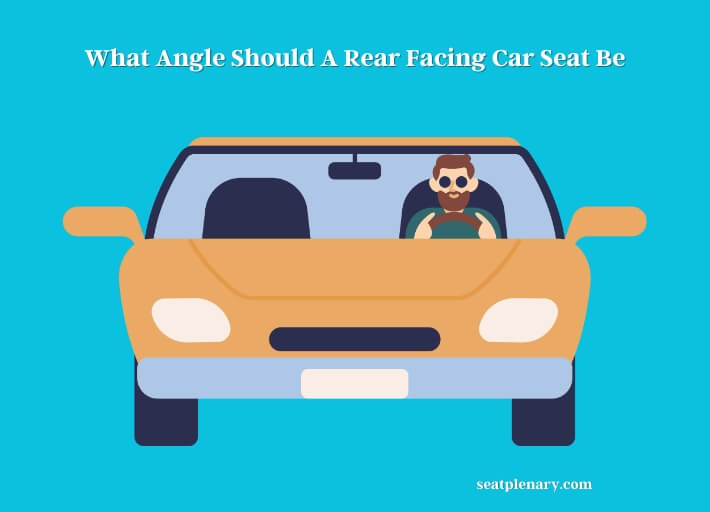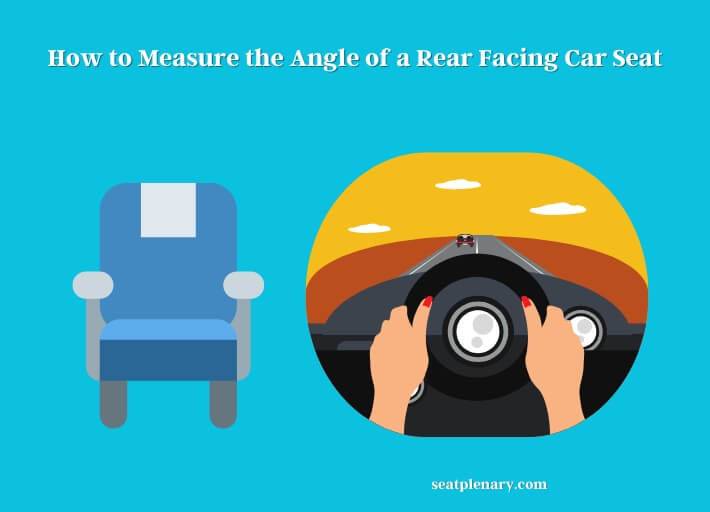When it comes to your child’s safety in a car, the smallest detail can make the most significant difference. One detail that often gets overlooked is the angle at which a rear-facing car seat should be. This angle is crucial for your baby’s safety and comfort. So, let’s delve into the question, what angle should a rear facing car seat be?

Why is the Angle of a Rear Facing Car Seat Important?
The angle of a rear-facing car seat is a seemingly small detail that carries substantial significance when it comes to ensuring the safety and comfort of your child. You may wonder, why is the angle so crucial?
Optimum Safety
Firstly, the angle of the car seat plays a significant role in the overall safety of the child in the case of a collision. During a crash, the forces exerted can be severe, and the angle of the car seat can influence how these forces are distributed. A correctly angled rear-facing car seat will allow these forces to spread across the child’s back and shoulders, the strongest parts of their body. This ensures that the sensitive areas like the neck and head are less prone to injury. If the car seat is too upright, your child’s body could move more than it should, potentially causing injury.
Prevents Head Flopping
Secondly, when the seat is too upright, the child’s head can flop forward, especially when they fall asleep. This head flopping can cause discomfort and, in severe cases, it can even interfere with their airway, making it difficult for the child to breathe. On the other hand, if the seat is excessively reclined, it can act as a ramp in a crash, launching the child up and out of the seat.
Promotes Comfort
Comfort is another key factor. Just like adults, children need to be comfortable during car rides. The correct angle ensures that they are seated comfortably, not too reclined or too upright. This makes for a more pleasant ride for the child and peace of mind for the parent knowing their child is both safe and comfortable.
The Recommended Angle
The American Academy of Pediatrics (AAP) recommends that rear-facing car seats should be installed at an angle of approximately 30 to 45 degrees from vertical. This angle ensures the child’s safety and comfort during car rides.
Factors Affecting the Ideal Car Seat Angle
The ideal angle for a rear-facing car seat isn’t a one-size-fits-all. Several factors can impact the perfect angle for a car seat. Here’s a closer look at some of these factors.
Type of Vehicle
Cars come in all shapes and sizes, and so do their interiors. The design and slope of your vehicle’s seats can significantly impact how a car seat fits and, consequently, the angle it can achieve. For instance, if your vehicle’s seat is heavily contoured or has a steep slope, it might be challenging to get a proper fit and angle for your car seat. On the contrary, if your vehicle’s seat is fairly flat, you might find it easier to achieve the recommended angle.
Design of the Car Seat
Different car seat models have varying design features, which can affect the achievable angle. Some car seats come with built-in angle adjusters, which allow for easier angle manipulation. Others may not have these features, and you may need to use external tools like a rolled towel or pool noodle to achieve the appropriate angle.
Child’s Age and Size
The age and size of your child also influence the ideal angle. Newborns and younger infants who cannot yet control their heads need a more reclined position (around 45 degrees) to keep their heads from flopping forward. As the child grows and gains more head and neck control, the seat can be more upright (around 30 degrees).
Installation Method
The method you use to install the car seat can also affect the angle. For instance, installing the seat using the vehicle’s seat belt might give a different angle compared to using the Lower Anchors and Tethers for Children (LATCH) system. It’s essential to follow the car seat manufacturer’s guidelines for installation to ensure both a secure fit and the correct angle.
How to Measure the Angle of a Rear Facing Car Seat
Knowing how to measure the angle of a rear-facing car seat is crucial to ensure its correct installation. With the right tools and a keen eye, it becomes a relatively straightforward process. Here’s how you can go about it:
Using Built-In Indicators
The majority of car seats come equipped with built-in angle indicators. These indicators, usually present as a line or a bubble indicator on the side of the seat, help parents determine if the seat is at the correct angle. When the seat is installed correctly, the line should be parallel to the ground, or the bubble should be within the appropriate range marked on the indicator.
Using a Smartphone App
If your car seat doesn’t have a built-in indicator, or if you want to double-check its accuracy, you can use a smartphone app. There are several apps available for both Android and iOS that use the phone’s built-in gyroscope to measure angles. Simply place the phone on the car seat and adjust until you reach the recommended angle. Remember, the ideal angle for a rear-facing car seat is between 30 to 45 degrees from vertical.

Using a Physical Level
In some cases, you might prefer using a physical level, a tool used to determine whether a surface is horizontal (level) or vertical (plumb). These are available at most hardware stores. While it might seem old-fashioned compared to digital options, a level can provide a reliable measurement for your car seat’s angle.
Adjusting the Angle of a Rear Facing Car Seat
Sometimes, despite your best efforts, you might find that your car seat isn’t quite at the right angle after installation. No need to fret! Adjusting the angle of a rear-facing car seat is possible and can be accomplished using a few different methods.
Using the Car Seat’s Built-In Adjusters
Many modern car seats come with built-in angle adjusters. These can be as simple as an adjustable foot on the base of the seat, which can be lengthened or shortened to adjust the angle. Others may have a more complex mechanism. Always refer to the car seat’s manual to understand how to use the built-in adjusters correctly. Also you can use- Diono Angle Adjuster Car Seat Leveler.
Using Rolled Towels or Pool Noodles
For car seats without built-in adjusters or when additional adjustment is needed, rolled towels or pool noodles can come to the rescue. This method is recommended by many safety experts and can be a cost-effective way to ensure the correct angle. Simply roll up a towel or cut a pool noodle to the right length, and place it under the front edge of the car seat. Always ensure the car seat is still securely installed and does not move more than an inch side-to-side or front-to-back at the belt path after using this method.
Getting Professional Help
If you’re having trouble achieving the right angle or if you’re unsure about your installation, don’t hesitate to seek professional help. Certified Child Passenger Safety Technicians (CPSTs) are trained to help parents install car seats correctly. You can often find them at local fire departments, police stations, or through the National Child Passenger Safety Certification program’s website. You can see also this (Rear-Facing Car Seat Installation- Correct 45° Angle by Erica M) video:
FAQs
Are the Rear Seats in an F150 Adjustable for Rear Facing Car Seats?
Yes, the rear seats in an F150 are adjustable and designed to accommodate rear-facing car seats. With rear seat connectivity options, parents can ensure a safe and comfortable ride for their little ones. The F150’s versatile seating arrangement allows for easy installation and proper positioning of rear-facing car seats, providing peace of mind for families on the go.
What angle should a rear facing car seat be?
A rear-facing car seat should be installed at an angle of 30 to 45 degrees from vertical, as recommended by the American Academy of Pediatrics.
Why is the angle of a rear facing car seat important?
The angle is important to ensure your child is sitting in the safest and most comfortable position possible. It prevents the child’s head from flopping forward and helps ensure proper protection during a collision.
Can I adjust the angle of a rear facing car seat?
Yes, the angle of a rear-facing car seat can be adjusted. This is often done using a rolled towel or pool noodle.
How do I know if my car seat is at the right angle?
Most car seats come with built-in angle indicators that show if the seat is installed correctly. You can also use a level or an angle finder to measure the angle of the seat.
How can the type of vehicle affect the ideal car seat angle?
The type of vehicle can affect the car seat angle due to differences in the design of vehicle seats. Some vehicle seats are more sloped or more flat, which can impact the angle at which a car seat can be installed.
Does the design of the car seat affect the optimal car seat angle?
Yes, different car seats come with different design features, such as built-in angle adjusters, which can impact the ideal angle for installation. Always follow the manufacturer’s instructions to ensure the correct angle.
Conclusion
The angle of a rear-facing car seat plays a crucial role in keeping your child safe and comfortable. It is recommended to install the car seat at an angle of 30 to 45 degrees from vertical.
Remember, each car and car seat is unique, so always follow the manufacturer’s instructions and use built-in angle indicators, a level, or an angle finder to ensure proper installation. A correctly installed car seat is one of the best ways to protect your child while on the road.
Read more:
